The Ultimate One-Bowl Lemon Ricotta Cake: Effortlessly Light, Fluffy, and Zestfully Delicious
Prepare to fall in love with this incredible Lemon Ricotta Cake! This recipe stands out not only for its unbelievably light and fluffy texture but also for its remarkable simplicity – it’s designed to be made entirely in just one bowl. Infused with the vibrant zest and bright tang of fresh lemons, balanced perfectly with the creamy richness of ricotta, this cake delivers a refreshing flavor that is simply irresistible. Whether you’re seeking an elegant dessert to cap off a special meal or a delightful treat to accompany your afternoon tea, this Italian-inspired ricotta cake is guaranteed to impress with minimal effort and maximum deliciousness.

[feast_advanced_jump_to]
Why You’ll Adore This Easy Lemon Ricotta Cake Recipe
There’s so much to cherish about this classic Italian Lemon and Ricotta Cake, making it a staple in any home baker’s repertoire. Its effortless preparation is arguably its greatest charm; imagine whipping up a sophisticated dessert in just one bowl, minimizing cleanup and maximizing your enjoyment! This cake isn’t just easy; it’s a testament to how simple ingredients can yield extraordinary results.
The star of the show is, of course, its uniquely light and unbelievably fluffy texture. Unlike denser butter cakes, the ricotta cheese imparts a tender, moist crumb that literally melts in your mouth, making each bite a delightful experience. It’s airy, delicate, and never heavy, ensuring you always have room for a second slice.
The magical pairing of bright, zesty lemon and creamy, mild ricotta is a culinary match made in heaven. This traditional combination, celebrated in Italian desserts, creates a beautifully balanced flavor profile. The lemon provides a refreshing tang and aromatic lift, perfectly complementing the subtle sweetness and delicate “cheese” notes of the ricotta. It’s a harmonious blend that feels both comforting and invigorating, reminiscent of sunshine on a spring day. If you’ve enjoyed my Lemon Ricotta Cheesecake, you’ll recognize and love this lighter, equally flavorful profile.
Beyond its incredible taste and texture, this lemon ricotta cake is wonderfully versatile. It shines as an elegant, light dessert to conclude any meal, offering a refreshing alternative to heavier puddings. It’s also the quintessential treat for an afternoon tea gathering, pairing beautifully with a hot cup of coffee or a fragrant herbal tea. Serve it simply dusted with powdered sugar, or elevate it further with a luscious berry sauce, a handful of fresh seasonal fruits, a vibrant and tangy Lemon Curd, or a dollop of freshly whipped cream. The possibilities are endless, making this cake a true crowd-pleaser for any occasion.
More Ricotta Recipes to explore:
- Spinach & Ricotta Rolls
- Pumpkin and Ricotta Tart
Understanding the Delight: What Exactly is Lemon Ricotta Cake?
Lemon Ricotta Cake, or Torta di Ricotta al Limone, is a cherished traditional Italian dessert that captures the essence of Mediterranean baking. While its precise origins are often attributed to the sunny island of Sicily, variations of this delightful cake are enjoyed across many regions of Italy, each boasting its own unique twist. At its heart, it’s a moist and tender cake distinguished by the inclusion of fresh ricotta cheese in the batter.
Unlike many conventional butter or sponge cakes, the ricotta plays a pivotal role in creating a distinctively light, airy, and incredibly moist crumb. It lends a subtle, delicate creaminess and a gentle ‘cheesy’ nuance that complements the bright acidity of the lemon beautifully, without being overpowering. This unique texture and flavor profile is what sets it apart, making it less dense than a cheesecake but more substantial and flavorful than a typical sponge.
Historically, Italian bakers often experimented with various flours, and while this particular recipe utilizes readily available wheat (all-purpose) flour for its soft texture and widespread accessibility, you might encounter other traditional versions. Some recipes call for semolina flour, which can impart a slightly coarser texture and a richer, more rustic flavor, while others use almond meal (farina di mandorle) for added richness, nutty flavor, and a gluten-friendly option. Regardless of the flour type, the core appeal of the Lemon Ricotta Cake lies in its harmonious blend of dairy and citrus, creating a dessert that feels both wholesome and indulgent.
Essential Ingredients for Your Perfect Lemon Ricotta Cake
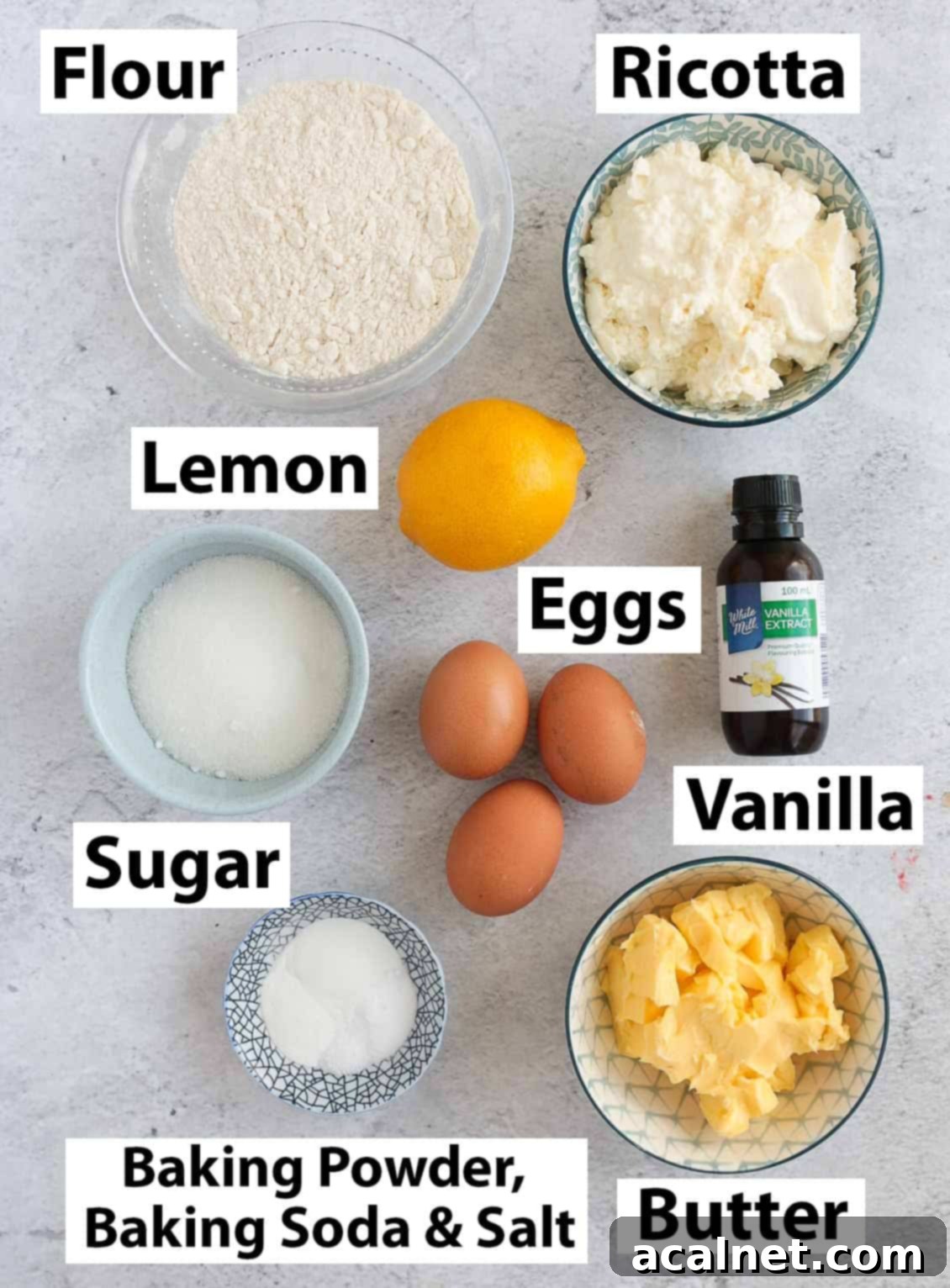
For precise measurements and full ingredient list, please refer to the recipe card below.
Crafting this deliciously light Lemon Ricotta Cake requires a few simple, high-quality ingredients, with particular attention to their preparation and temperature. Here’s what you’ll need to achieve that perfect fluffy texture and bright, zesty flavor:
- Unsalted Butter: Ensure your butter is very soft and at room temperature. This is absolutely critical for proper creaming with the sugar. Cold butter won’t emulsify correctly, leading to a denser cake. Unsalted butter allows you to control the overall salt content of your bake.
- Caster Sugar: This fine granulated sugar dissolves beautifully into the butter, contributing to the light and airy texture of the cake.
- Fresh Lemons: You’ll need both the vibrant zest and the tangy juice. Always wash your lemons thoroughly before zesting. The zest contains essential oils that provide a much deeper, more aromatic lemon flavor than juice alone. Feel free to add a little extra zest if you desire an even more pronounced lemon punch.
- Full-Fat Ricotta Cheese: Opt for unsalted, whole milk (full-fat) ricotta at room temperature. This ingredient is the secret to the cake’s signature moistness and tender crumb. Light or skim ricotta will significantly compromise both the flavor and the texture, resulting in a drier, less rich cake. If your ricotta appears watery, drain it first by placing it in a fine-mesh sieve lined with cheesecloth over a bowl for at least 30 minutes, or even overnight in the fridge, to remove any excess liquid. This prevents a soggy cake.
- Large Eggs: Like the butter and ricotta, your eggs should be at room temperature. Room temperature eggs emulsify more easily with the other ingredients, creating a smoother, more uniform batter and a better rise.
- Vanilla Extract: A touch of pure vanilla extract enhances the overall flavor profile, adding a warm, sweet undertone that complements the lemon and ricotta.
- Plain / All-Purpose Flour: Standard all-purpose flour provides the structural base for the cake. If you prefer to use Self-Rising Flour, simply substitute it cup-for-cup and omit the separate baking powder and baking soda, as they are already included in self-rising flour.
- Baking Powder & Baking Soda: These leavening agents work in harmony to give the cake its lift and airy texture. Ensure they are fresh for optimal rising.
- Fine Table Salt: A small pinch of salt balances the sweetness and enhances all the other flavors in the cake.
Optional Enhancements for Your Ricotta Cake
While delicious on its own, a few optional additions can further customize and elevate your Lemon Ricotta Cake:
- Lemon Extract: For those who crave an intensely bright lemon flavor, a few drops of good quality lemon extract can be added alongside the vanilla extract. Exercise caution, as lemon extract is potent, and a little goes a long way.
- Flaked Almonds: Sprinkle a handful of flaked almonds over the top of the cake batter before baking. They add a lovely subtle crunch and a beautiful visual appeal, toasting lightly in the oven.
- Icing Sugar / Powdered Sugar Dusting: A classic and elegant finish. Once the cake has cooled, a delicate dusting of icing sugar (also known as powdered sugar) adds a touch of sweetness and sophistication. For an extra burst of freshness and aroma, grate a little more lemon zest directly over the cake just before serving.
- Poppy Seeds: For a delightful texture and a classic flavor pairing, mix 1-2 tablespoons of poppy seeds into the batter with the dry ingredients.
- Fresh Berries: Gently fold in a handful of fresh blueberries or raspberries into the batter just before baking for bursts of fruity flavor and color.
Step-by-Step Guide: How to Bake the Perfect Lemon Ricotta Cake
Making this delightful Lemon Ricotta Cake is a wonderfully straightforward process, especially since it’s designed as a convenient one-bowl recipe. While a hand mixer or stand mixer will certainly make the task easier and yield the fluffiest results, you can also achieve a beautiful cake with a good old-fashioned whisk and a bit of elbow grease. The key to its signature super fluffy crumb lies in thoroughly creaming the butter and sugar, a step greatly facilitated by a mixer.
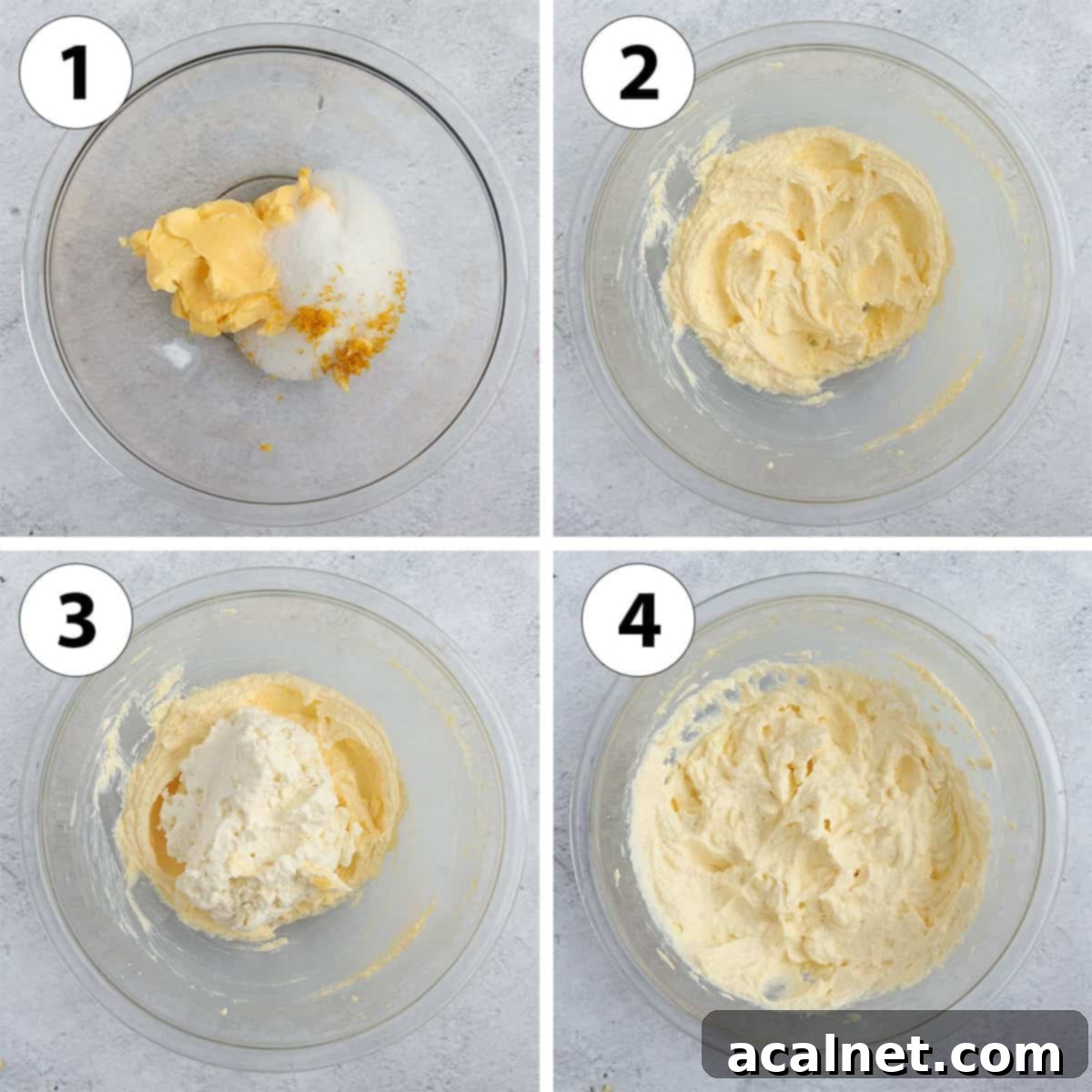
- Prepare Your Oven and Pan: Begin by preheating your oven to 180 degrees Celsius (350 degrees Fahrenheit). Next, prepare your 24 cm / 9-inch Springform Pan. Line the bottom with parchment paper and lightly grease the sides. This crucial step ensures your delicate cake won’t stick and will release cleanly after baking.
- Cream the Wet Ingredients (Photo 1 & 2): In a large mixing bowl (or the bowl of your stand mixer), combine the very soft, room-temperature unsalted butter, caster sugar, and finely grated lemon zest. Cream these ingredients together on medium to medium-high speed for a good 3 to 5 minutes. You’re aiming for a mixture that is significantly lighter in color, pale, and wonderfully fluffy, almost doubled in volume. This aeration is vital for creating the cake’s airy texture.
- Incorporate Ricotta and Eggs (Photo 3, 4 & 5): Add the room-temperature full-fat ricotta cheese to the creamed butter mixture. Continue mixing on medium speed for a couple more minutes until it’s fully incorporated and the mixture is smooth and lump-free. Then, add the large room-temperature eggs, one at a time. Mix slowly after each addition until just combined before adding the next. This allows each egg to fully emulsify into the batter. If your batter appears to curdle slightly at this stage, don’t panic! It often happens if ingredients are too cold or not creamed enough, but it will come together once the flour is added.
- Add Liquid Flavorings (Photo 6): Gently mix in the fresh lemon juice and vanilla extract until just combined. It’s perfectly normal for the batter to appear like it’s splitting or curdling slightly after adding the lemon juice due to its acidity reacting with the dairy. Rest assured, this is a temporary reaction.
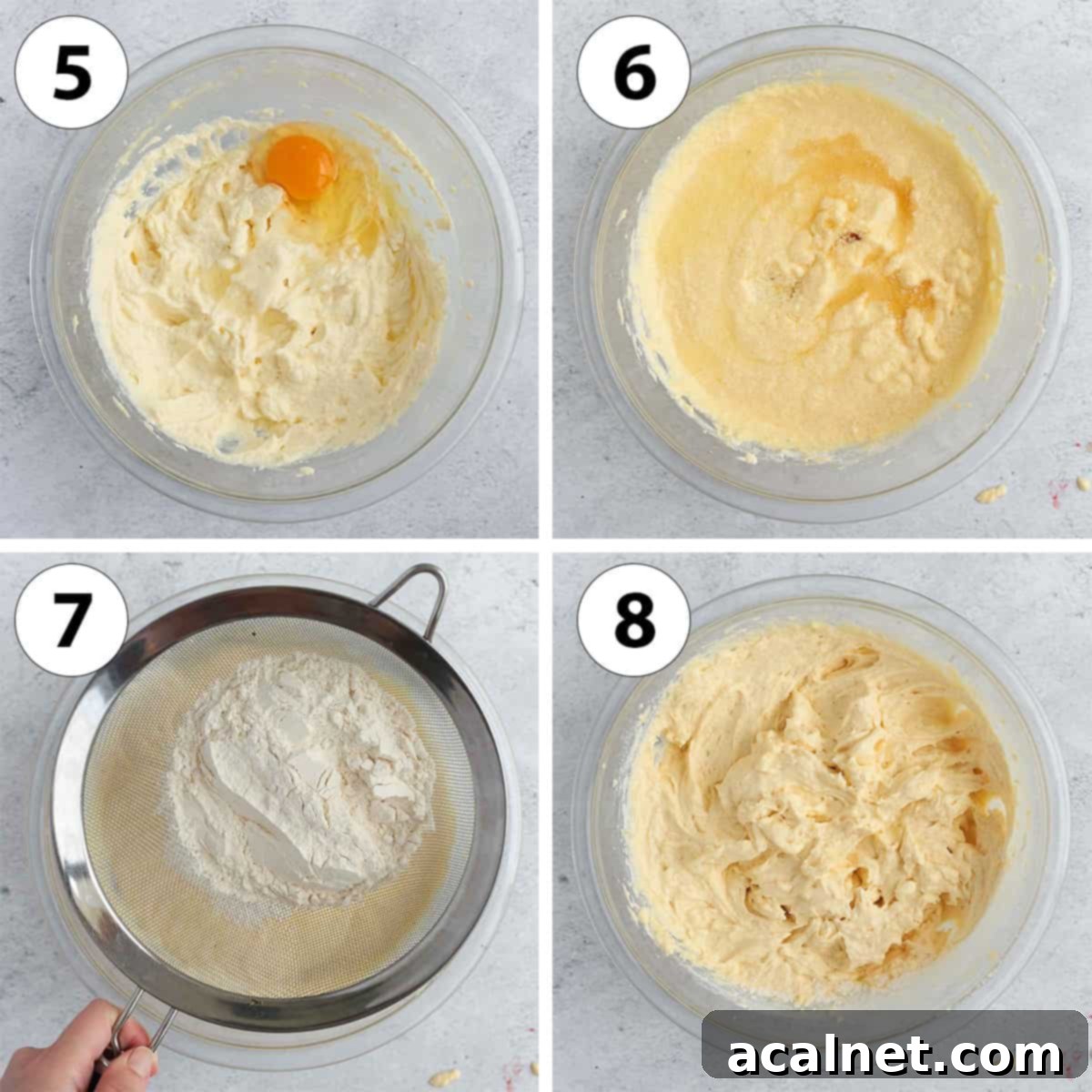
- Combine with Dry Ingredients (Photo 7 & 8): Sift the plain/all-purpose flour, baking powder, baking soda, and a pinch of salt directly into the wet ingredients. Sifting helps to aerate the dry ingredients and prevent lumps. Mix slowly on low speed or, even better, by hand with a whisk or spatula, until the flour is just incorporated. It’s crucial not to overmix the batter at this stage, as overworking the gluten can result in a tough, dense cake. Stop mixing as soon as no dry streaks of flour are visible.
- Bake to Golden Perfection: Pour the smooth cake batter into your prepared springform pan. Use a spatula or the back of a spoon to gently spread it into an even layer, ensuring consistent baking.
- Baking and Cooling: Bake for approximately 35 to 40 minutes. The cake is done when it’s beautifully golden brown on top and a wooden skewer inserted into the center comes out clean. Once baked, remove the cake from the oven and allow it to cool completely in the pan on a wire rack. This cake is quite delicate when warm, so patience is key! Trying to remove it too soon might cause it to break.
- Final Touches: For a simple yet elegant finish, dust the cooled Lemon Ricotta Cake generously with icing sugar (powdered sugar) and grate a little fresh lemon zest over the top just before serving. This adds both visual appeal and an extra layer of bright citrus aroma.

Expert Tips for a Flawless Lemon Ricotta Cake Every Time
Achieving bakery-quality results with this Lemon Ricotta Cake is simple, especially when you follow these key tips:
- Proper Pan Preparation is Paramount: This cake, while sturdy when cooled, can be delicate. To ensure a smooth release and prevent any sticking issues, always take the time to prepare your springform pan meticulously. Line the bottom with a circle of parchment paper, and generously grease the sides with butter or a non-stick baking spray. This creates a non-stick barrier that will make removing the cake effortless once it’s fully cooled.
- Master the Art of Creaming Butter and Sugar: This step is the cornerstone of the cake’s incredibly airy and fluffy texture. Cream the very soft butter, sugar, and lemon zest together on medium-high speed for a full 3 to 5 minutes. You’re not just mixing; you’re incorporating air, which acts as a leavening agent. The mixture should become noticeably pale, light, and almost doubled in volume. A good test for proper creaming is to rub a small amount between your fingers; you should feel little to no grittiness from the sugar, indicating it has mostly dissolved into the butter and a stable emulsion has formed.
- Embrace Room Temperature Ingredients: This tip cannot be stressed enough! For a perfectly smooth batter and optimal emulsification, ensure all your dairy ingredients – especially the butter, eggs, and ricotta cheese – are at true room temperature. If these ingredients are too cold, they will cause the soft creamed butter to seize and harden, resulting in a lumpy, curdled batter that won’t bake up as light and fluffy. Plan ahead and take them out of the fridge at least 30-60 minutes before you start baking.
- Don’t Fret Over a “Split” Batter: When you add the lemon juice to the wet ingredients, it’s quite common for the batter to appear to curdle or split slightly due to the acidity reacting with the dairy. This is a normal chemical reaction and absolutely nothing to worry about! The batter will magically come back together and smooth out once you incorporate the dry ingredients. Just keep mixing gently.
- Patience During Cooling is a Virtue: The Lemon Ricotta Cake is wonderfully light and tender straight from the oven, which also makes it fragile. Attempting to remove it from the pan while it’s still warm will almost certainly result in cracks or breakage. For best results and a beautifully intact cake, allow it to cool down completely on a wire rack within the springform pan. Once completely cool, it will be much firmer and easier to handle for slicing and serving.
- Ensure Your Ricotta is Drained: If your ricotta cheese seems particularly wet or has visible liquid, take a few extra minutes to drain it. Place it in a fine-mesh sieve lined with cheesecloth or a coffee filter over a bowl and let it sit for at least 30 minutes, or even a few hours in the refrigerator. Removing excess moisture will prevent your cake from becoming soggy and ensure a superior texture.

Frequently Asked Questions About Lemon Ricotta Cake
For the absolute best results in terms of flavor, moisture, and that signature light, fluffy texture, always opt for Full Fat / Whole Milk Ricotta. Skim or light ricotta contains more water and less fat, which will lead to a noticeably drier, denser, and less flavorful cake. The richness from the whole milk ricotta is essential for achieving the desired crumb and delicate taste. Remember to drain any excess liquid if your ricotta seems too wet.
Several factors can contribute to a cake that doesn’t rise as expected:
– Insufficient Creaming: The crucial step of creaming butter and sugar together for 3-5 minutes is where much of the cake’s lift originates. This process incorporates tiny air bubbles, which expand in the oven, creating a light and airy structure. If this step is rushed or not done thoroughly, you lose that vital initial leavening.
– Expired Leavening Agents: Always check the freshness of your baking powder and baking soda. If they are old or expired, they won’t react properly and won’t provide the necessary lift.
– Oven Temperature Issues: An oven that is too cool can cause the cake to rise slowly and result in a flatter, denser product. Conversely, an oven that’s too hot can set the crust too quickly, preventing the interior from fully rising. Ensure your oven is accurately calibrated (an oven thermometer is a great investment!).
– Cold Ingredients: As mentioned in our tips, cold butter, eggs, or ricotta can prevent proper emulsification and creaming, hindering the cake’s ability to rise optimally.
– Overmixing the Batter: Once you add the flour, overmixing develops the gluten too much, leading to a tough and dense cake that won’t rise as high. Mix only until the dry ingredients are just incorporated.
Yes, absolutely! If you have self-rising flour on hand, you can substitute it for the plain / all-purpose flour in this recipe. Just make sure to use the exact same amount by weight or volume. Since self-rising flour already contains baking powder and salt, you should discard the separate baking powder and baking soda listed in the recipe. This will prevent your cake from having an off-texture or metallic taste due to too much leavening.
Yes, this cake is wonderfully adaptable! Fresh berries like blueberries, raspberries, or finely chopped strawberries make excellent additions. Gently fold about 1/2 to 1 cup of your chosen fruit into the batter just before pouring it into the pan. You can also add a layer of thinly sliced apples or pears on top of the batter before baking for a different fruity twist.
To maintain its freshness and delicate texture, store your Lemon Ricotta Cake well-covered or in an airtight container at room temperature for up to 2-3 days. For longer storage, you can keep it in the refrigerator for up to 3 days, although it tends to dry out a bit more quickly when chilled. Always ensure it’s fully cooled before storing.
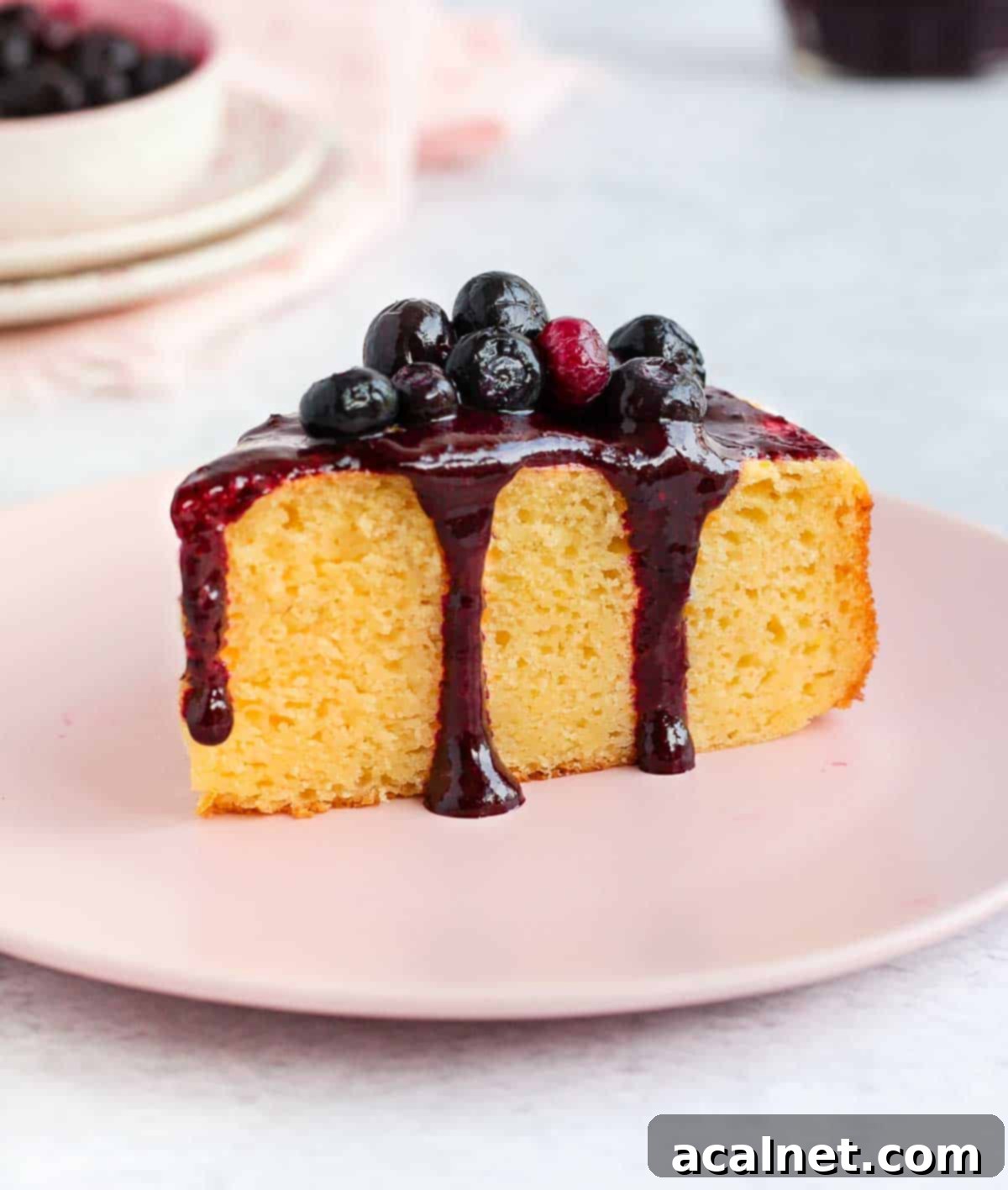
Delightful Serving Suggestions for Your Lemon Ricotta Cake
The beauty of this Lemon Ricotta Cake lies not just in its exquisite flavor and texture, but also in its incredible versatility when it comes to serving. While it’s utterly delicious simply on its own, a thoughtful accompaniment can elevate your dessert experience even further. I personally adore serving this cake with a vibrant, homemade Blueberry Compote, as the bright tartness of the berries provides a fantastic contrast to the cake’s creamy sweetness. Generally, any form of fresh berries, berry sauce, or a light cream pairs beautifully.
Here are some of my favorite ideas to inspire your serving:
- Fresh Berry Coulis: Drizzle your slice with a vibrant, smooth Strawberry Coulis, a delicate Raspberry Coulis, or a rich Blueberry Coulis. These fruit sauces add a burst of fruity flavor and a beautiful visual element.
- Warm Berry Compotes: A slightly warmed Mixed Berry Compote, a sweet Strawberry Compote, or a tangy Raspberry Compote adds a rustic charm and wonderful depth of flavor. The warm fruit softens the cake slightly, creating an inviting contrast in temperatures.
- Zesty Lemon Curd: For lemon lovers, a dollop of tangy Lemon Curd on the side or spread thinly over a slice amplifies the citrus notes and adds an extra layer of luxurious smoothness.
- Stewed Fruits: Consider serving with seasonal Stewed Rhubarb for a tart counterpoint, or comforting Stewed Pears for a softer, sweeter option. These offer a homey, comforting feel.
- Whipped Cream or Chantilly Cream: A cloud of simply whipped cream or a delicately sweetened Chantilly cream provides a classic, light, and refreshing accompaniment that highlights the cake’s own airy qualities.
- Fresh Berries: Sometimes, the simplest garnishes are the best. A handful of fresh blueberries, raspberries, or sliced strawberries scattered around the cake, perhaps with a sprig of mint, makes for an effortlessly elegant presentation.
Storing and Freezing Your Lemon Ricotta Cake
Proper storage is key to enjoying your delicious Lemon Ricotta Cake for as long as possible while maintaining its exquisite texture and flavor. After the cake has completely cooled, you have a couple of options:
- Room Temperature Storage: This cake stores beautifully at room temperature. Ensure it is well covered with plastic wrap or stored in an airtight container to prevent it from drying out. It will stay wonderfully moist and fresh for up to 2-3 days. Storing it on the counter allows the flavors to meld beautifully and keeps the cake at its most tender.
- Refrigerator Storage: If you need to store it for a bit longer, or if your kitchen is particularly warm, you can keep the cake in the refrigerator for up to 3 days. Again, ensure it’s tightly covered in plastic wrap or placed in an airtight container. Be aware that refrigeration can sometimes alter the cake’s texture slightly, making it a little denser and potentially causing it to dry out more quickly compared to room temperature storage. For the best experience, bring refrigerated slices back to room temperature for about 30 minutes before serving.
Freezing Recommendation: While many cakes freeze well, I generally do not recommend freezing this Lemon Ricotta Cake. The delicate, light, and moist crumb that makes this cake so special is highly susceptible to textural changes during the freezing and thawing process. Freezing tends to make the ricotta cheese grainy and can cause the cake to become less airy and more crumbly or even rubbery once defrosted. To truly appreciate its unique qualities, it’s best enjoyed fresh within a few days of baking.
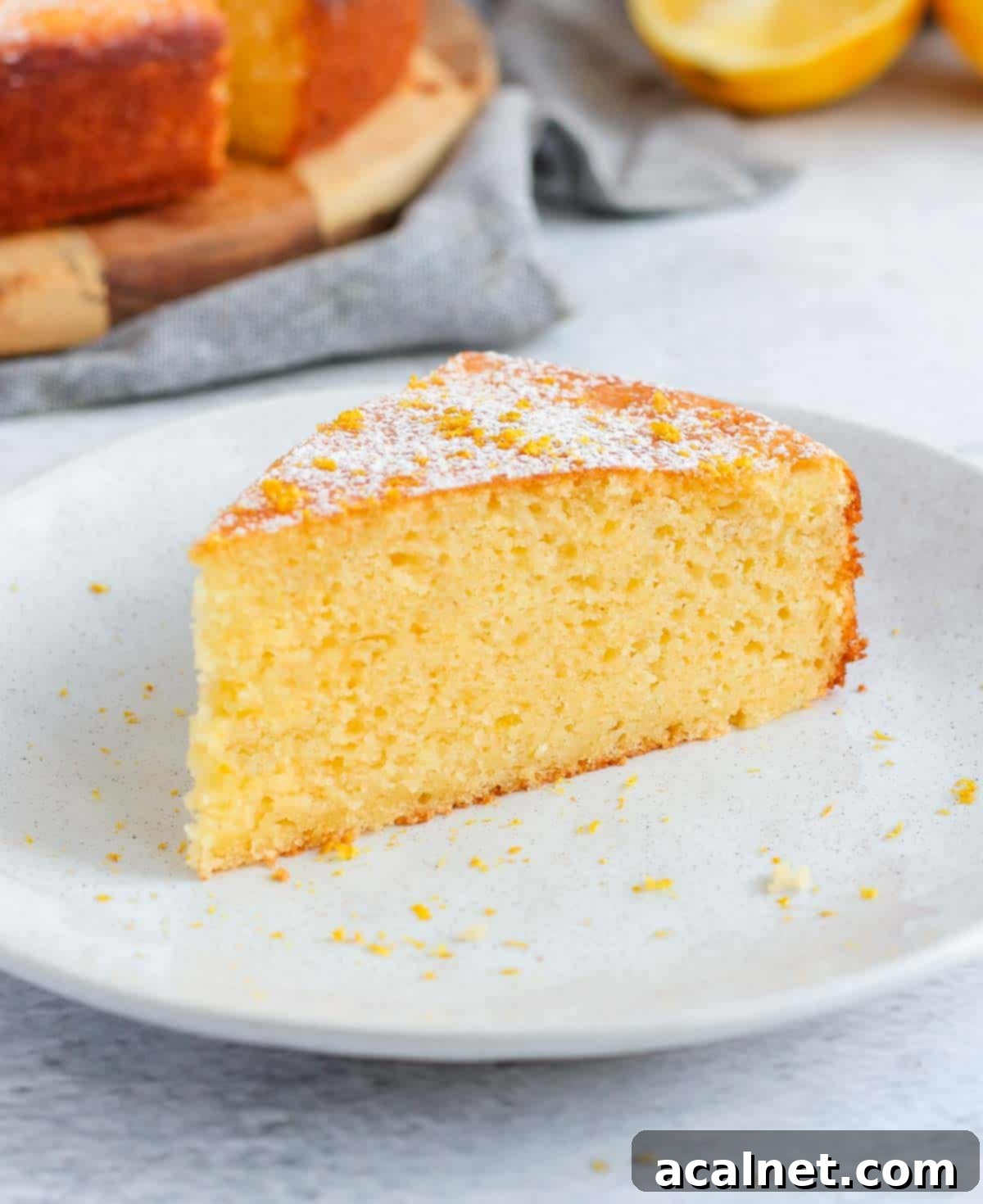
More Lemon Desserts You’ll Love
- Lemon Poppy Seed Loaf Cake
- Mini Lemon Curd Tartlets
- Lemon Ricotta Cheesecake
- Mini Lemon Cheesecakes
- Lemon Mousse
- Lemon Curd Cookies
Made this recipe?
Let us know if you liked it by leaving a comment below, and tag us on Instagram @a.baking.journey with a photo of your creation!
Recipe Card

Lemon Ricotta Cake
Print Recipe
Ingredients
- 120 gr (1/2 cup) Unsalted Butter, soft, at room temperature
- 120 gr (1/2 cup + 1 tablespoon) Caster Sugar
- 3 teaspoon Lemon Zest, about 2 large lemon
- 60 ml (1/4) Lemon Juice, about 1 large lemon
- 250 gr (8.75 oz or 1 cup) Full Fat Ricotta Cheese, at room temperature
- 3 large Eggs, at room temperature
- 1 teaspoon Vanilla Extract
- 200 gr (1 1/3 cup) Plain / All-Purpose Flour
- 1 1/2 teaspoon Baking Powder
- 1/2 teaspoon Baking Soda
- 1 pinch Fine Table Salt
Instructions
- Preheat your oven on 180’C / 350’F. Line the bottom of a 24cm / 9″ Springform Pan with baking paper and lightly grease the edges.
- In a large bowl (or the bowl of your mixer), cream together the Butter, Sugar and Lemon Zest on medium to medium high speed for 3 to 5 minutes (see note 1).
- Add the Ricotta Cheese and mix for a couple of minutes. Add the Eggs one at the time, mixing slowly until combined. Mix in the Lemon Juice and Vanilla Extract (see note 2).
- Sift in the Flour, Baking Powder, Baking Soda and Salt. Slowly mix and stop as soon as combined to avoid overworking the batter.
- Transfer into the prepared Springform Pan. Use a spatula or the back of a spoon to spread and smooth out the batter if needed.
- Bake for 35 to 40 minutes or until a skewer comes out clean. Leave to cool down completely before removing from the pan (see note 3).
- Optional: to finish the cake, dust it with a little bit of Icing Sugar and the Zest of a Lemon.
Would you like to save this recipe?
We’ll email this post to you, so you can come back to it later!
Notes
- You should get a very light, pale and fluffy texture that will create an airy crumb for the cake. You can cream and mix the ingredients by hands with a whisk if preferred but I highly recommend using a hand or stand mixer for better results. If the butter is not at room temperature or soft enough, it will be hard to cream it and you will get small chunks of un-mixed butter in the batter.
- Don’t worry if the batter seem to split / curdle when you add the lemon juice, it’ a normal reaction. The batter will come back together when you add the dry ingredients.
- The cake will be very soft when it comes out of the oven and might break if you try to move it out of the pan straight away. Make sure it is cool before removing it from the pan.
Nutrition (per serving)
